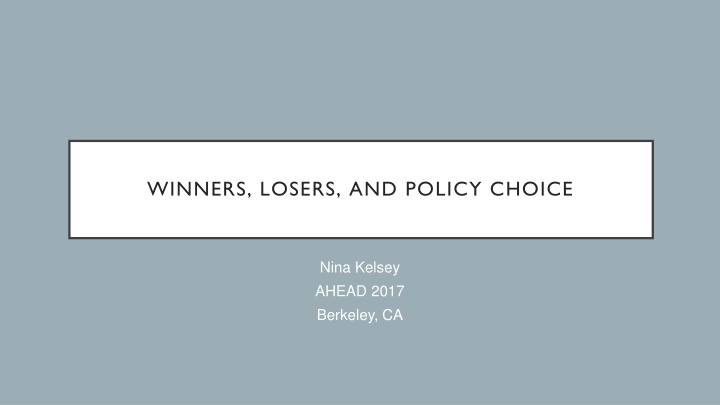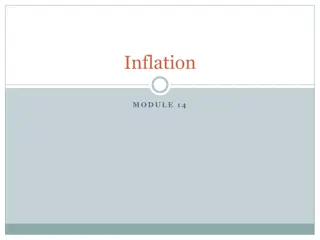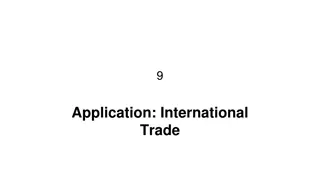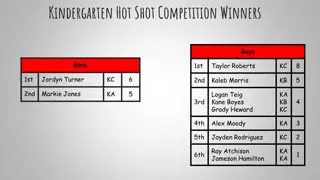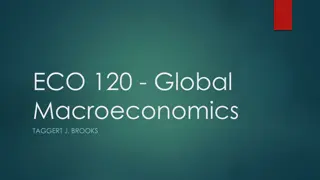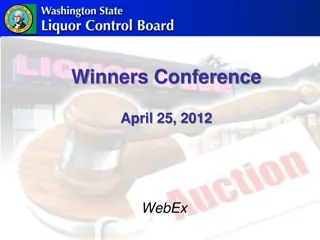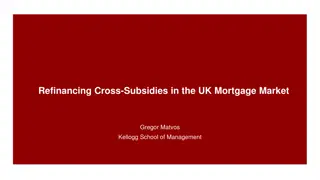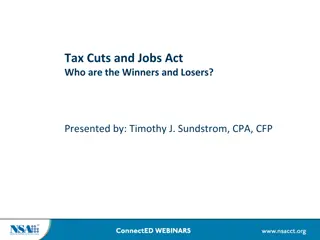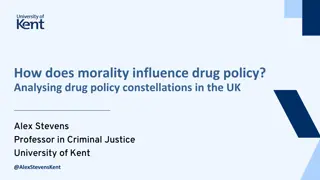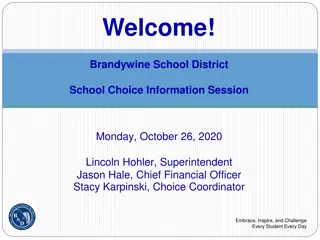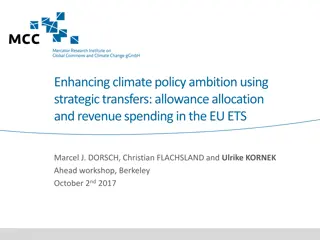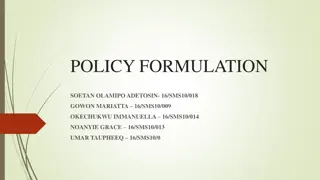WINNERS, LOSERS, AND POLICY CHOICE
This event discussion centers around examining winners and losers in policy choices, providing insights and strategies for better decision-making. Featuring a lineup of notable speakers and experts, the event aims to delve deep into policy implications and strategies for shaping a more inclusive future.
Download Presentation

Please find below an Image/Link to download the presentation.
The content on the website is provided AS IS for your information and personal use only. It may not be sold, licensed, or shared on other websites without obtaining consent from the author.If you encounter any issues during the download, it is possible that the publisher has removed the file from their server.
You are allowed to download the files provided on this website for personal or commercial use, subject to the condition that they are used lawfully. All files are the property of their respective owners.
The content on the website is provided AS IS for your information and personal use only. It may not be sold, licensed, or shared on other websites without obtaining consent from the author.
E N D
Presentation Transcript
WINNERS, LOSERS, AND POLICY CHOICE Nina Kelsey AHEAD 2017 Berkeley, CA
EXPLORING DYNAMIC RELATIONSHIPS BETWEEN POLICY AND INTERESTS How do policy choices shape interests? Does policy choice mediate distributional outcomes? Our recent project looked at whether RE policy choice shaped RE generation asset ownership outcomes Does the type of industry matter? Ongoing project Does feedback between policy and interest changes happen at the citizen level? Project under development
DISTRIBUTIONAL RESULTS OF POLICY CHOICE: RE GENERATION ASSET OWNERSHIP Initial theory: RPS vs. FIT x Liberalized vs. Unliberalized Does RPS vs. FIT drive mix of USG (large owners) vs. DG (small and auto-producers)? RPSs more USG; FITs more distributed autoproducers Does liberalization status drive mix of ownership by incumbent utilities vs. challenger independent power producers? Unliberalized more utility; Liberalized more IPP This doesn t really turn out to be the case.
RESULTS: RENEWABLE POLICY CHOICE Average USG shares of renewable energy capacity by policy category 100% Differences were not statistically significant. 75% However, we do note a trend in both regions consistent with the hypothesis 50% 92% 81% 78% 76% 75% Meanwhile, results on liberalization showed no consistent policy effect. Regardless of liberalization status, IPPs win everywhere. 68% 25% 0% FIT? Only FIT? +? RPS RPS? Only Neither FIT? Only FIT+RPS RPS? Only Neither EU? USG EU? DG US? USG US? DG
WHAT DOES DRIVE DISTRIBUTIONAL OUTCOMES? UTILITY VS. IPP For Utility/IPP, drawing on existing literature, the dynamics of technological transition and innovation and related utility strategic mistakes? (Hockerts and Wu stenhagen 2010, Groot 2013, Graffy and Kihm 2014) (Richter 2013b, Kungl 2015) Basically, legacy utilities tend to have legacy business models and expertise that are less well suited to new technologies
WHAT DOES DRIVE DISTRIBUTIONAL OUTCOMES? USG VS. DG WIND SOLAR 60 60 50 50 Wind? Actual? Rank Solar? Actual? Rank 40 40 30 30 20 20 10 10 0 0 0 10 20 30 40 50 60 0 10 20 30 40 50 60 Wind? Potential? Rank Solar? Potential? Rank US? Wind EU? Wind Linear? ? (US? Wind) Linear? ? (EU? Wind) US? Solar? PV? EU? Solar? PV Linear? ? (US? Solar? PV? ) Linear? ? (? EU? Solar? PV) (very significant) (not at all significant) We think the prevalence of USG is driven by wind s economic value...
WHAT DOES DRIVE DISTRIBUTIONAL OUTCOMES? USG VS. DG WIND SOLAR 60 60 50 50 Wind? Actual? Rank Solar? Actual? Rank 40 40 30 30 20 20 10 10 0 0 0 10 20 30 40 50 60 0 10 20 30 40 50 60 Wind? Potential? Rank Solar? Potential? Rank US? Wind EU? Wind Linear? ? (US? Wind) Linear? ? (EU? Wind) US? Solar? PV? EU? Solar? PV Linear? ? (US? Solar? PV? ) Linear? ? (? EU? Solar? PV) (not at all significant) (very significant) ...but while something causes variation in solar, it doesn t look like it s resources.
SO WHATS GOING ON WITH SOLAR? We think policy matters, just not the policy we initially looked at. Case: New England states Still mostly RPS Low solar resources But lots of (solar) DG! Land-poor SRECs
TAKE-AWAYS Policy choices can make a difference in distributional outcomes, but but the battles may be more at the very high level (support vs. lack of support) and the lower policy design level (e.g. whether you include provisions that specifically support solar). This project looked at a pretty specific distributional outcome ownership of generation assets, largely by industry. We imagine a wealth of more sophisticated work looking at how policy and interests interact, especially with more focus on other areas of climate policy and on more individual-level perceptions of interest.
ONGOING/UPCOMING PROJECTS Drilling down into policy choice and distributional outcomes: casework in Germany and California looking at more detailed dynamics Impact of industry characteristics on potential for positive feedback between policy moves and industry interest shifts: do some types of industry have greater potential to support these types of dynamics? (Ongoing case study work) Dynamic relationship between policy, investment, and citizen-level interests: do voters near areas of substantial renewable energy investment/development perceive themselves as having interests in green policy? (Survey experiment in development)
